Analysis of Team Roles and Contributions in Organizational Settings
VerifiedAdded on 2020/07/22
|7
|1925
|47
Report
AI Summary
This report provides a comprehensive analysis of team contribution and its impact on organizational effectiveness. It begins by examining the organizational structure of Daxko, a small software company, and the role of the manager within this structure, highlighting the importance of communication. The report then delves into Tuckman's four stages of team development, emphasizing the significance of understanding roles and responsibilities for reducing conflicts and achieving team goals. It identifies key factors contributing to team effectiveness, such as open discussion, logical arguments, and unified goals, along with strategies for increasing team involvement in decision-making and planning. Furthermore, it outlines ways to enhance individual contributions to a team and explores the roles of team members and leaders in improving team performance. The report stresses the importance of open communication and documentation of conflicts for enhancing team effectiveness and organizational success, referencing relevant literature throughout.
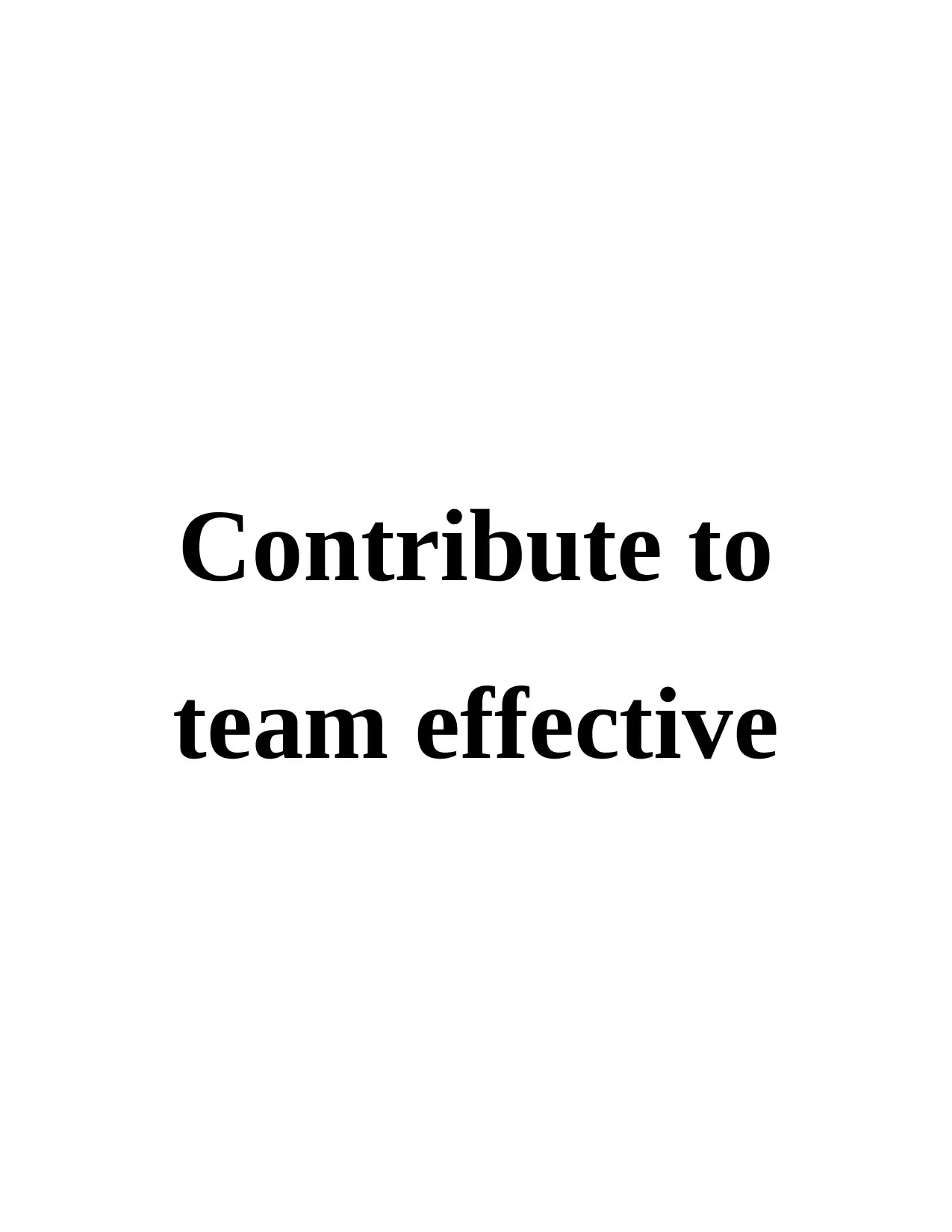
Contribute to
team effective
team effective
Paraphrase This Document
Need a fresh take? Get an instant paraphrase of this document with our AI Paraphraser
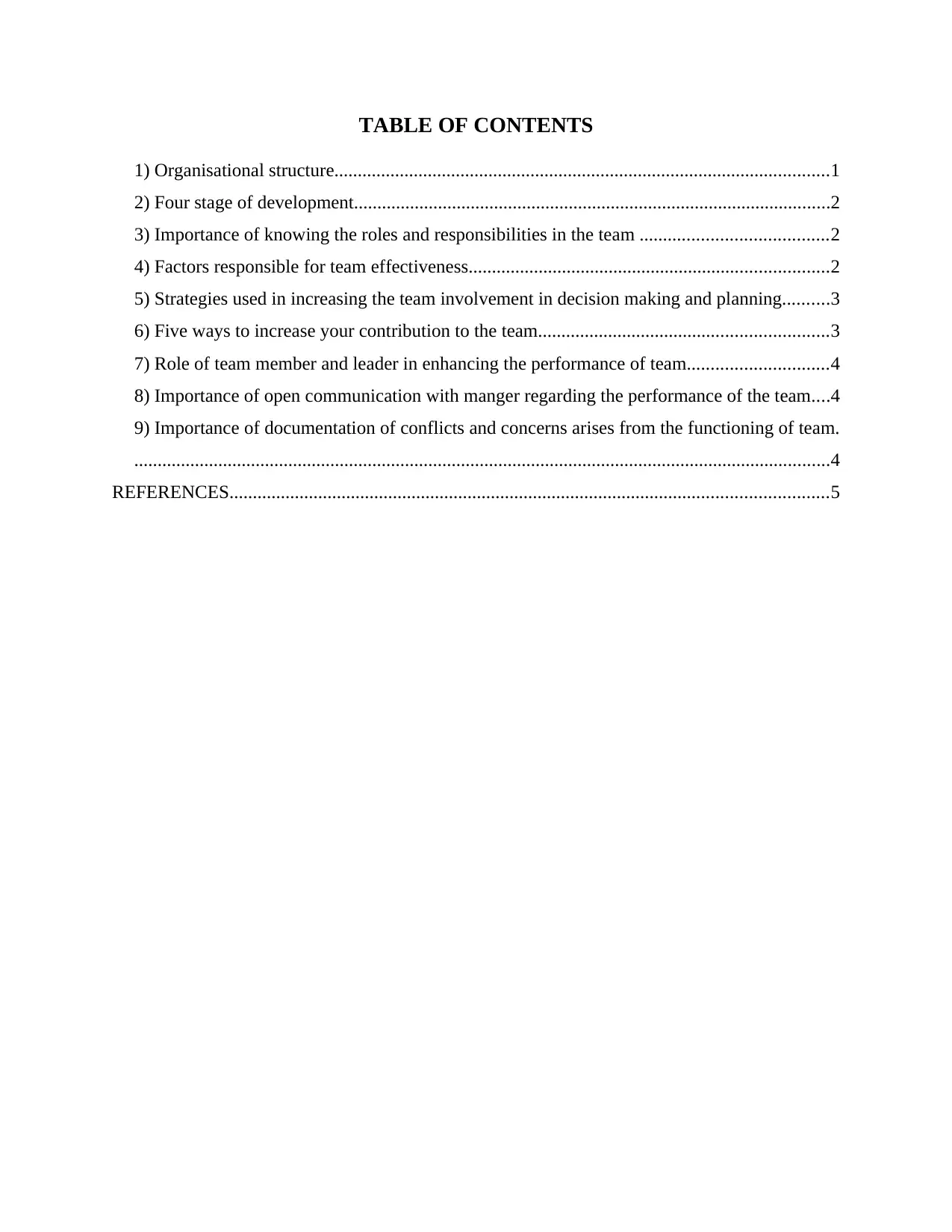
TABLE OF CONTENTS
1) Organisational structure..........................................................................................................1
2) Four stage of development......................................................................................................2
3) Importance of knowing the roles and responsibilities in the team ........................................2
4) Factors responsible for team effectiveness.............................................................................2
5) Strategies used in increasing the team involvement in decision making and planning..........3
6) Five ways to increase your contribution to the team..............................................................3
7) Role of team member and leader in enhancing the performance of team..............................4
8) Importance of open communication with manger regarding the performance of the team....4
9) Importance of documentation of conflicts and concerns arises from the functioning of team.
.....................................................................................................................................................4
REFERENCES................................................................................................................................5
1) Organisational structure..........................................................................................................1
2) Four stage of development......................................................................................................2
3) Importance of knowing the roles and responsibilities in the team ........................................2
4) Factors responsible for team effectiveness.............................................................................2
5) Strategies used in increasing the team involvement in decision making and planning..........3
6) Five ways to increase your contribution to the team..............................................................3
7) Role of team member and leader in enhancing the performance of team..............................4
8) Importance of open communication with manger regarding the performance of the team....4
9) Importance of documentation of conflicts and concerns arises from the functioning of team.
.....................................................................................................................................................4
REFERENCES................................................................................................................................5
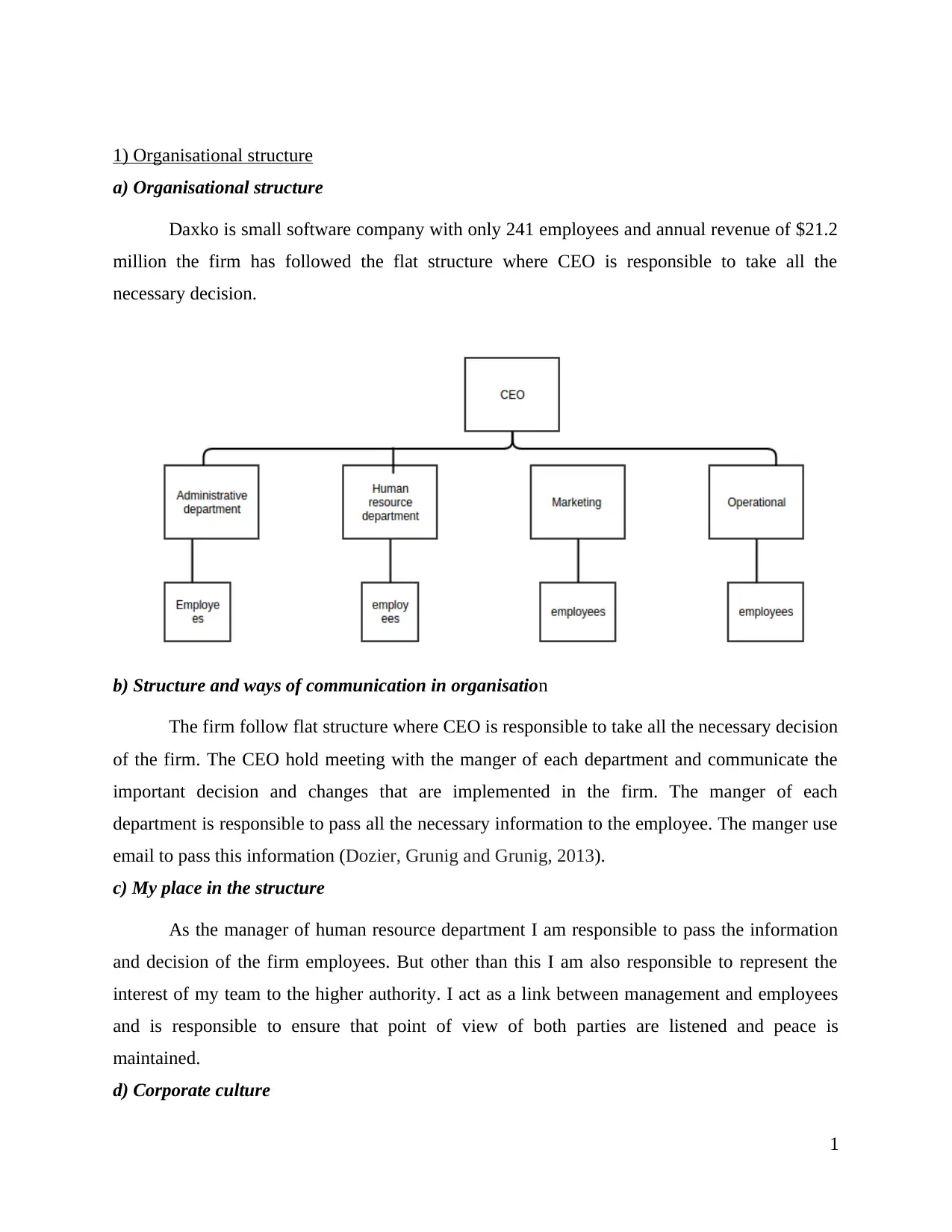
1) Organisational structure
a) Organisational structure
Daxko is small software company with only 241 employees and annual revenue of $21.2
million the firm has followed the flat structure where CEO is responsible to take all the
necessary decision.
b) Structure and ways of communication in organisation
The firm follow flat structure where CEO is responsible to take all the necessary decision
of the firm. The CEO hold meeting with the manger of each department and communicate the
important decision and changes that are implemented in the firm. The manger of each
department is responsible to pass all the necessary information to the employee. The manger use
email to pass this information (Dozier, Grunig and Grunig, 2013).
c) My place in the structure
As the manager of human resource department I am responsible to pass the information
and decision of the firm employees. But other than this I am also responsible to represent the
interest of my team to the higher authority. I act as a link between management and employees
and is responsible to ensure that point of view of both parties are listened and peace is
maintained.
d) Corporate culture
1
a) Organisational structure
Daxko is small software company with only 241 employees and annual revenue of $21.2
million the firm has followed the flat structure where CEO is responsible to take all the
necessary decision.
b) Structure and ways of communication in organisation
The firm follow flat structure where CEO is responsible to take all the necessary decision
of the firm. The CEO hold meeting with the manger of each department and communicate the
important decision and changes that are implemented in the firm. The manger of each
department is responsible to pass all the necessary information to the employee. The manger use
email to pass this information (Dozier, Grunig and Grunig, 2013).
c) My place in the structure
As the manager of human resource department I am responsible to pass the information
and decision of the firm employees. But other than this I am also responsible to represent the
interest of my team to the higher authority. I act as a link between management and employees
and is responsible to ensure that point of view of both parties are listened and peace is
maintained.
d) Corporate culture
1
⊘ This is a preview!⊘
Do you want full access?
Subscribe today to unlock all pages.

Trusted by 1+ million students worldwide
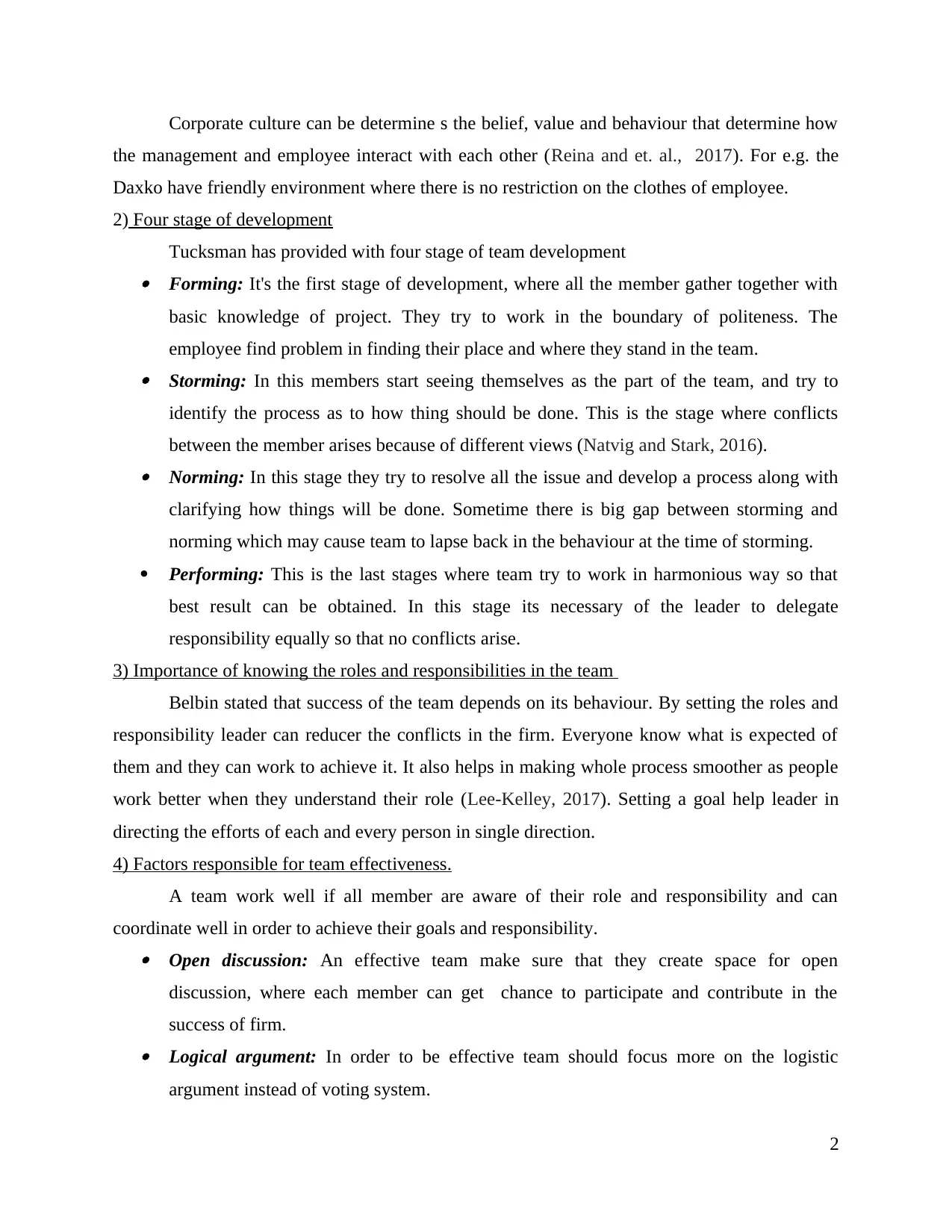
Corporate culture can be determine s the belief, value and behaviour that determine how
the management and employee interact with each other (Reina and et. al., 2017). For e.g. the
Daxko have friendly environment where there is no restriction on the clothes of employee.
2) Four stage of development
Tucksman has provided with four stage of team development Forming: It's the first stage of development, where all the member gather together with
basic knowledge of project. They try to work in the boundary of politeness. The
employee find problem in finding their place and where they stand in the team. Storming: In this members start seeing themselves as the part of the team, and try to
identify the process as to how thing should be done. This is the stage where conflicts
between the member arises because of different views (Natvig and Stark, 2016). Norming: In this stage they try to resolve all the issue and develop a process along with
clarifying how things will be done. Sometime there is big gap between storming and
norming which may cause team to lapse back in the behaviour at the time of storming.
Performing: This is the last stages where team try to work in harmonious way so that
best result can be obtained. In this stage its necessary of the leader to delegate
responsibility equally so that no conflicts arise.
3) Importance of knowing the roles and responsibilities in the team
Belbin stated that success of the team depends on its behaviour. By setting the roles and
responsibility leader can reducer the conflicts in the firm. Everyone know what is expected of
them and they can work to achieve it. It also helps in making whole process smoother as people
work better when they understand their role (Lee-Kelley, 2017). Setting a goal help leader in
directing the efforts of each and every person in single direction.
4) Factors responsible for team effectiveness.
A team work well if all member are aware of their role and responsibility and can
coordinate well in order to achieve their goals and responsibility. Open discussion: An effective team make sure that they create space for open
discussion, where each member can get chance to participate and contribute in the
success of firm. Logical argument: In order to be effective team should focus more on the logistic
argument instead of voting system.
2
the management and employee interact with each other (Reina and et. al., 2017). For e.g. the
Daxko have friendly environment where there is no restriction on the clothes of employee.
2) Four stage of development
Tucksman has provided with four stage of team development Forming: It's the first stage of development, where all the member gather together with
basic knowledge of project. They try to work in the boundary of politeness. The
employee find problem in finding their place and where they stand in the team. Storming: In this members start seeing themselves as the part of the team, and try to
identify the process as to how thing should be done. This is the stage where conflicts
between the member arises because of different views (Natvig and Stark, 2016). Norming: In this stage they try to resolve all the issue and develop a process along with
clarifying how things will be done. Sometime there is big gap between storming and
norming which may cause team to lapse back in the behaviour at the time of storming.
Performing: This is the last stages where team try to work in harmonious way so that
best result can be obtained. In this stage its necessary of the leader to delegate
responsibility equally so that no conflicts arise.
3) Importance of knowing the roles and responsibilities in the team
Belbin stated that success of the team depends on its behaviour. By setting the roles and
responsibility leader can reducer the conflicts in the firm. Everyone know what is expected of
them and they can work to achieve it. It also helps in making whole process smoother as people
work better when they understand their role (Lee-Kelley, 2017). Setting a goal help leader in
directing the efforts of each and every person in single direction.
4) Factors responsible for team effectiveness.
A team work well if all member are aware of their role and responsibility and can
coordinate well in order to achieve their goals and responsibility. Open discussion: An effective team make sure that they create space for open
discussion, where each member can get chance to participate and contribute in the
success of firm. Logical argument: In order to be effective team should focus more on the logistic
argument instead of voting system.
2
Paraphrase This Document
Need a fresh take? Get an instant paraphrase of this document with our AI Paraphraser
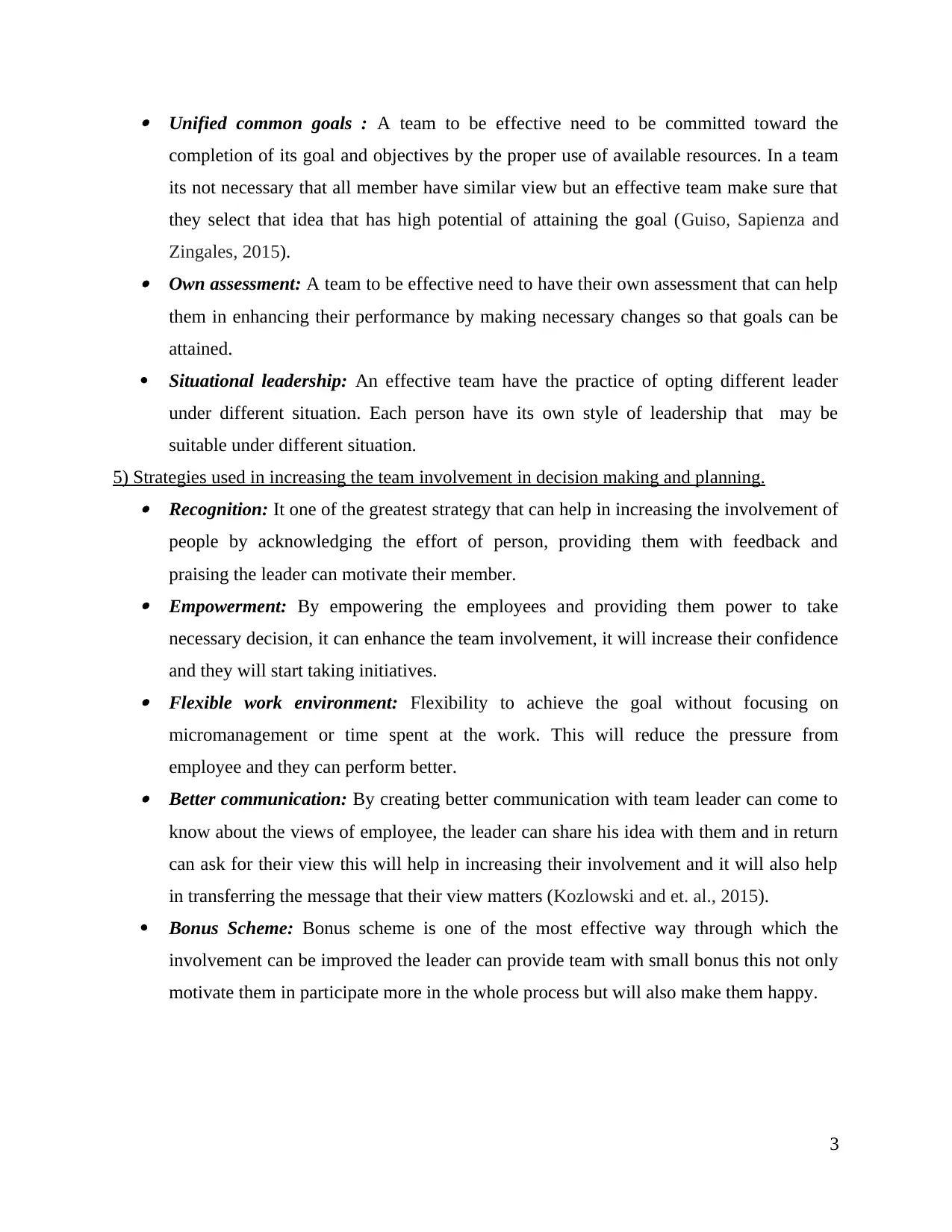
Unified common goals : A team to be effective need to be committed toward the
completion of its goal and objectives by the proper use of available resources. In a team
its not necessary that all member have similar view but an effective team make sure that
they select that idea that has high potential of attaining the goal (Guiso, Sapienza and
Zingales, 2015). Own assessment: A team to be effective need to have their own assessment that can help
them in enhancing their performance by making necessary changes so that goals can be
attained.
Situational leadership: An effective team have the practice of opting different leader
under different situation. Each person have its own style of leadership that may be
suitable under different situation.
5) Strategies used in increasing the team involvement in decision making and planning. Recognition: It one of the greatest strategy that can help in increasing the involvement of
people by acknowledging the effort of person, providing them with feedback and
praising the leader can motivate their member. Empowerment: By empowering the employees and providing them power to take
necessary decision, it can enhance the team involvement, it will increase their confidence
and they will start taking initiatives. Flexible work environment: Flexibility to achieve the goal without focusing on
micromanagement or time spent at the work. This will reduce the pressure from
employee and they can perform better. Better communication: By creating better communication with team leader can come to
know about the views of employee, the leader can share his idea with them and in return
can ask for their view this will help in increasing their involvement and it will also help
in transferring the message that their view matters (Kozlowski and et. al., 2015).
Bonus Scheme: Bonus scheme is one of the most effective way through which the
involvement can be improved the leader can provide team with small bonus this not only
motivate them in participate more in the whole process but will also make them happy.
3
completion of its goal and objectives by the proper use of available resources. In a team
its not necessary that all member have similar view but an effective team make sure that
they select that idea that has high potential of attaining the goal (Guiso, Sapienza and
Zingales, 2015). Own assessment: A team to be effective need to have their own assessment that can help
them in enhancing their performance by making necessary changes so that goals can be
attained.
Situational leadership: An effective team have the practice of opting different leader
under different situation. Each person have its own style of leadership that may be
suitable under different situation.
5) Strategies used in increasing the team involvement in decision making and planning. Recognition: It one of the greatest strategy that can help in increasing the involvement of
people by acknowledging the effort of person, providing them with feedback and
praising the leader can motivate their member. Empowerment: By empowering the employees and providing them power to take
necessary decision, it can enhance the team involvement, it will increase their confidence
and they will start taking initiatives. Flexible work environment: Flexibility to achieve the goal without focusing on
micromanagement or time spent at the work. This will reduce the pressure from
employee and they can perform better. Better communication: By creating better communication with team leader can come to
know about the views of employee, the leader can share his idea with them and in return
can ask for their view this will help in increasing their involvement and it will also help
in transferring the message that their view matters (Kozlowski and et. al., 2015).
Bonus Scheme: Bonus scheme is one of the most effective way through which the
involvement can be improved the leader can provide team with small bonus this not only
motivate them in participate more in the whole process but will also make them happy.
3
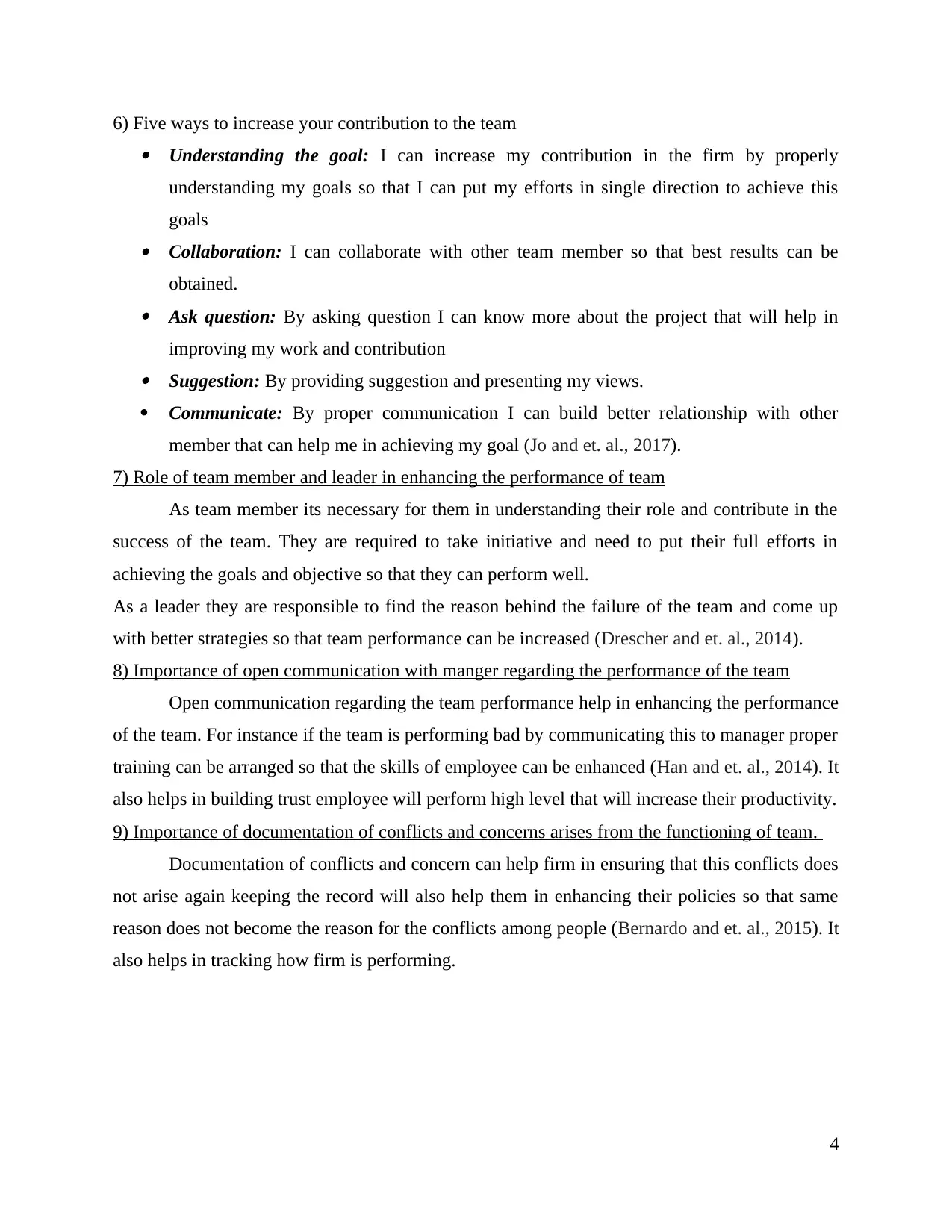
6) Five ways to increase your contribution to the team Understanding the goal: I can increase my contribution in the firm by properly
understanding my goals so that I can put my efforts in single direction to achieve this
goals Collaboration: I can collaborate with other team member so that best results can be
obtained. Ask question: By asking question I can know more about the project that will help in
improving my work and contribution Suggestion: By providing suggestion and presenting my views.
Communicate: By proper communication I can build better relationship with other
member that can help me in achieving my goal (Jo and et. al., 2017).
7) Role of team member and leader in enhancing the performance of team
As team member its necessary for them in understanding their role and contribute in the
success of the team. They are required to take initiative and need to put their full efforts in
achieving the goals and objective so that they can perform well.
As a leader they are responsible to find the reason behind the failure of the team and come up
with better strategies so that team performance can be increased (Drescher and et. al., 2014).
8) Importance of open communication with manger regarding the performance of the team
Open communication regarding the team performance help in enhancing the performance
of the team. For instance if the team is performing bad by communicating this to manager proper
training can be arranged so that the skills of employee can be enhanced (Han and et. al., 2014). It
also helps in building trust employee will perform high level that will increase their productivity.
9) Importance of documentation of conflicts and concerns arises from the functioning of team.
Documentation of conflicts and concern can help firm in ensuring that this conflicts does
not arise again keeping the record will also help them in enhancing their policies so that same
reason does not become the reason for the conflicts among people (Bernardo and et. al., 2015). It
also helps in tracking how firm is performing.
4
understanding my goals so that I can put my efforts in single direction to achieve this
goals Collaboration: I can collaborate with other team member so that best results can be
obtained. Ask question: By asking question I can know more about the project that will help in
improving my work and contribution Suggestion: By providing suggestion and presenting my views.
Communicate: By proper communication I can build better relationship with other
member that can help me in achieving my goal (Jo and et. al., 2017).
7) Role of team member and leader in enhancing the performance of team
As team member its necessary for them in understanding their role and contribute in the
success of the team. They are required to take initiative and need to put their full efforts in
achieving the goals and objective so that they can perform well.
As a leader they are responsible to find the reason behind the failure of the team and come up
with better strategies so that team performance can be increased (Drescher and et. al., 2014).
8) Importance of open communication with manger regarding the performance of the team
Open communication regarding the team performance help in enhancing the performance
of the team. For instance if the team is performing bad by communicating this to manager proper
training can be arranged so that the skills of employee can be enhanced (Han and et. al., 2014). It
also helps in building trust employee will perform high level that will increase their productivity.
9) Importance of documentation of conflicts and concerns arises from the functioning of team.
Documentation of conflicts and concern can help firm in ensuring that this conflicts does
not arise again keeping the record will also help them in enhancing their policies so that same
reason does not become the reason for the conflicts among people (Bernardo and et. al., 2015). It
also helps in tracking how firm is performing.
4
⊘ This is a preview!⊘
Do you want full access?
Subscribe today to unlock all pages.

Trusted by 1+ million students worldwide
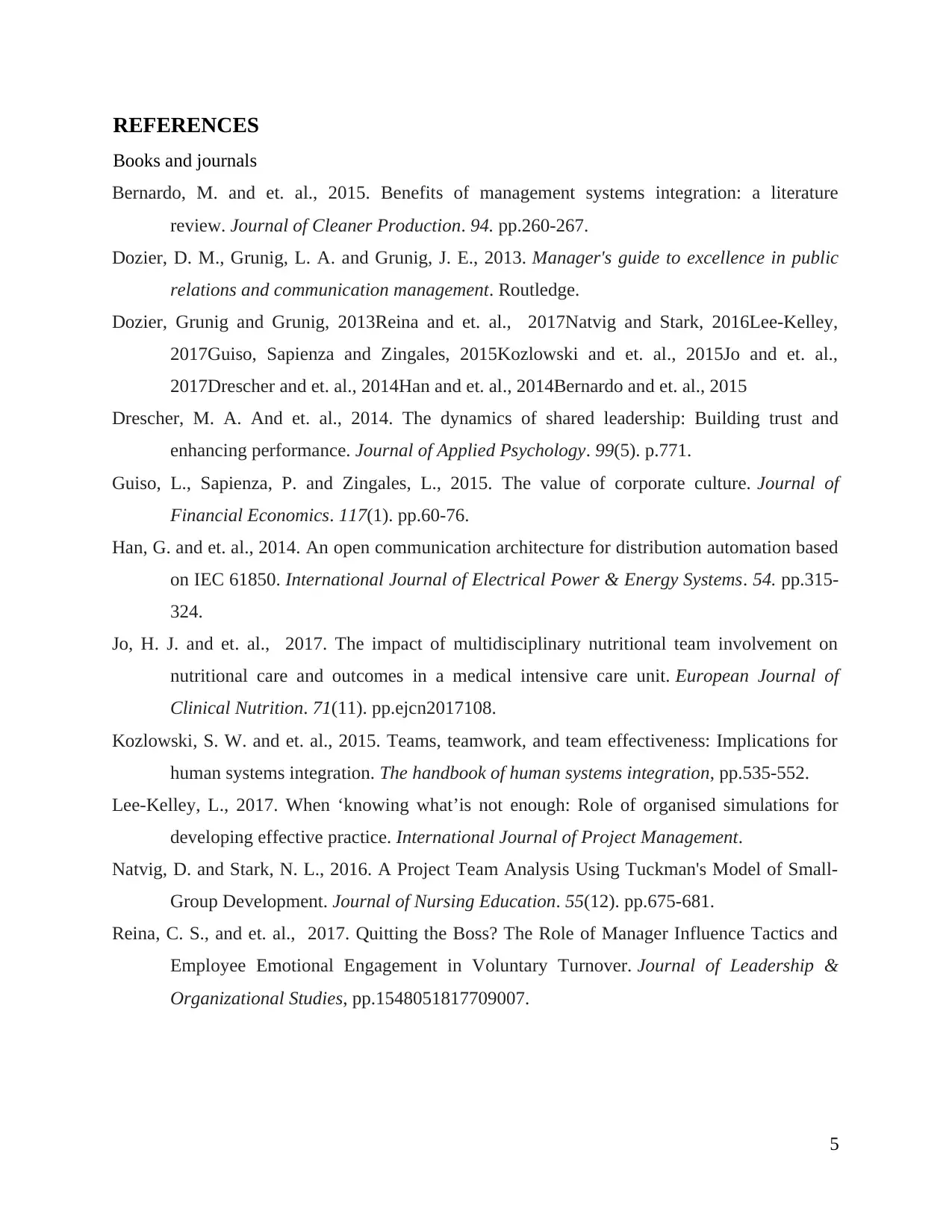
REFERENCES
Books and journals
Bernardo, M. and et. al., 2015. Benefits of management systems integration: a literature
review. Journal of Cleaner Production. 94. pp.260-267.
Dozier, D. M., Grunig, L. A. and Grunig, J. E., 2013. Manager's guide to excellence in public
relations and communication management. Routledge.
Dozier, Grunig and Grunig, 2013Reina and et. al., 2017Natvig and Stark, 2016Lee-Kelley,
2017Guiso, Sapienza and Zingales, 2015Kozlowski and et. al., 2015Jo and et. al.,
2017Drescher and et. al., 2014Han and et. al., 2014Bernardo and et. al., 2015
Drescher, M. A. And et. al., 2014. The dynamics of shared leadership: Building trust and
enhancing performance. Journal of Applied Psychology. 99(5). p.771.
Guiso, L., Sapienza, P. and Zingales, L., 2015. The value of corporate culture. Journal of
Financial Economics. 117(1). pp.60-76.
Han, G. and et. al., 2014. An open communication architecture for distribution automation based
on IEC 61850. International Journal of Electrical Power & Energy Systems. 54. pp.315-
324.
Jo, H. J. and et. al., 2017. The impact of multidisciplinary nutritional team involvement on
nutritional care and outcomes in a medical intensive care unit. European Journal of
Clinical Nutrition. 71(11). pp.ejcn2017108.
Kozlowski, S. W. and et. al., 2015. Teams, teamwork, and team effectiveness: Implications for
human systems integration. The handbook of human systems integration, pp.535-552.
Lee-Kelley, L., 2017. When ‘knowing what’is not enough: Role of organised simulations for
developing effective practice. International Journal of Project Management.
Natvig, D. and Stark, N. L., 2016. A Project Team Analysis Using Tuckman's Model of Small-
Group Development. Journal of Nursing Education. 55(12). pp.675-681.
Reina, C. S., and et. al., 2017. Quitting the Boss? The Role of Manager Influence Tactics and
Employee Emotional Engagement in Voluntary Turnover. Journal of Leadership &
Organizational Studies, pp.1548051817709007.
5
Books and journals
Bernardo, M. and et. al., 2015. Benefits of management systems integration: a literature
review. Journal of Cleaner Production. 94. pp.260-267.
Dozier, D. M., Grunig, L. A. and Grunig, J. E., 2013. Manager's guide to excellence in public
relations and communication management. Routledge.
Dozier, Grunig and Grunig, 2013Reina and et. al., 2017Natvig and Stark, 2016Lee-Kelley,
2017Guiso, Sapienza and Zingales, 2015Kozlowski and et. al., 2015Jo and et. al.,
2017Drescher and et. al., 2014Han and et. al., 2014Bernardo and et. al., 2015
Drescher, M. A. And et. al., 2014. The dynamics of shared leadership: Building trust and
enhancing performance. Journal of Applied Psychology. 99(5). p.771.
Guiso, L., Sapienza, P. and Zingales, L., 2015. The value of corporate culture. Journal of
Financial Economics. 117(1). pp.60-76.
Han, G. and et. al., 2014. An open communication architecture for distribution automation based
on IEC 61850. International Journal of Electrical Power & Energy Systems. 54. pp.315-
324.
Jo, H. J. and et. al., 2017. The impact of multidisciplinary nutritional team involvement on
nutritional care and outcomes in a medical intensive care unit. European Journal of
Clinical Nutrition. 71(11). pp.ejcn2017108.
Kozlowski, S. W. and et. al., 2015. Teams, teamwork, and team effectiveness: Implications for
human systems integration. The handbook of human systems integration, pp.535-552.
Lee-Kelley, L., 2017. When ‘knowing what’is not enough: Role of organised simulations for
developing effective practice. International Journal of Project Management.
Natvig, D. and Stark, N. L., 2016. A Project Team Analysis Using Tuckman's Model of Small-
Group Development. Journal of Nursing Education. 55(12). pp.675-681.
Reina, C. S., and et. al., 2017. Quitting the Boss? The Role of Manager Influence Tactics and
Employee Emotional Engagement in Voluntary Turnover. Journal of Leadership &
Organizational Studies, pp.1548051817709007.
5
1 out of 7
Related Documents
Your All-in-One AI-Powered Toolkit for Academic Success.
+13062052269
info@desklib.com
Available 24*7 on WhatsApp / Email
![[object Object]](/_next/static/media/star-bottom.7253800d.svg)
Unlock your academic potential
Copyright © 2020–2025 A2Z Services. All Rights Reserved. Developed and managed by ZUCOL.





